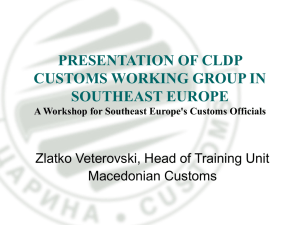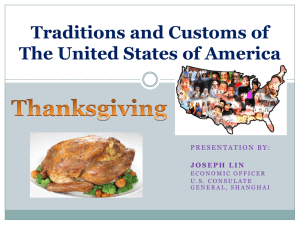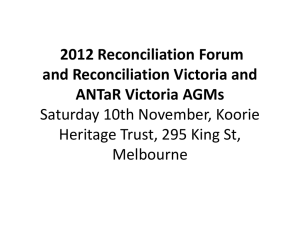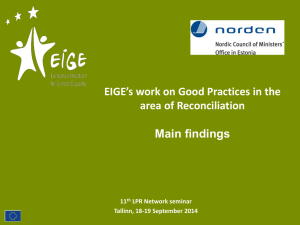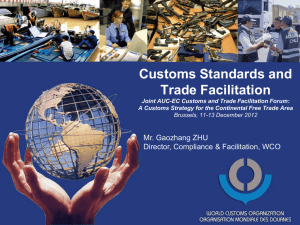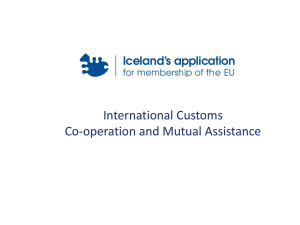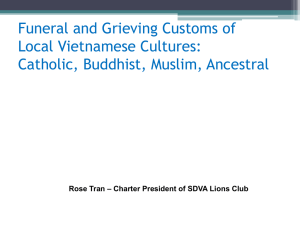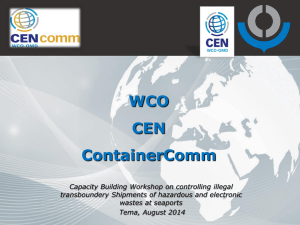U.S. Customs Reconciliation
advertisement
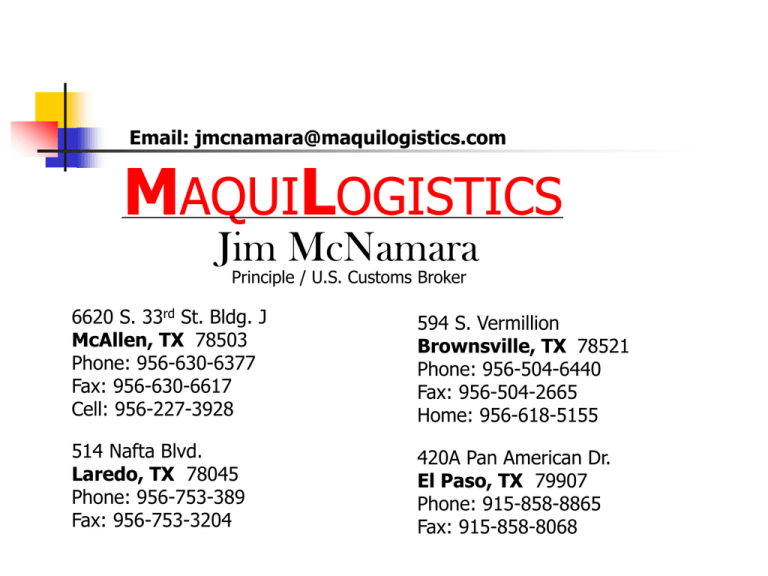
Email: jmcnamara@maquilogistics.com MAQUILOGISTICS Jim McNamara Principle / U.S. Customs Broker 6620 S. 33rd St. Bldg. J McAllen, TX 78503 Phone: 956-630-6377 Fax: 956-630-6617 Cell: 956-227-3928 594 S. Vermillion Brownsville, TX 78521 Phone: 956-504-6440 Fax: 956-504-2665 Home: 956-618-5155 514 Nafta Blvd. Laredo, TX 78045 Phone: 956-753-389 Fax: 956-753-3204 420A Pan American Dr. El Paso, TX 79907 Phone: 915-858-8865 Fax: 915-858-8068 Historical Perspective on Reconciliation - Began early 1970’s U.S. Customs Import Specialist /Brownsville. - Originally “U.S. Customs Quarterly Cost Submission” (Custom . Form CF247). - Later changed to 6 months and then yearly “Cost Submissions”. - Almost universally maquilas did a “Cost Submission” - Yearly “Cost Submissions” due by 3 months after close of year . but extensions were often granted (month by month often for . several months… no specific limit) Historical Perspective on Reconciliation - Cost Submission necessary because Maquila’s used estimated . values to pay U.S. Customs duties when importing “finished . products” into U.S. - Cost Submission compared “estimated values” with “actual costs” . and calculated difference in duty “+ or –” based on variances. - Used concept of “block appraisement” whereby duties were . “refunded” or “paid” on minimum number of entries possible. - First 10 or 11 months of entries were liquidated as “no change” . and all charges concentrated on last 1 or 2 months entries. - Liquidation is an important legal process whereby Customs makes . a determination as to whether to accept import entry information. Historical Perspective on Reconciliation - Process was totally “manual”; hard copy CF247 submitted to U.S. . Customs with no receipt or acknowledgement. - Cost Submission information regarding changes to entries not . interfaced with other systems that potentially charged duty . amounts on entry (for example drawback). - Double dipping, or receiving refunds two times on given entries . possible. - If U.S. Customs import specialist changed or import manager with . Maquila’s changed often files were misplaced by either or both . parties. Historical Perspective on Reconciliation - Customs and importer sometimes didn’t know if an annual . submission had been filed or how or even if refunds on . additional payments had been done. - Refunding money often took a long period of time and was . sometimes difficult to track. - Sometimes if variation was large on a refund not enough . entries were left to refund total amount due on entries. - Despite it’s potential flaws the cost submission process . usually worked very well for over 20 years. Historical Perspective on Reconciliation - However, U.S. General Accounting Office (GAO) issued a very . negative audit on U.S. Customs stating that “Cost Submission” . process lacked proper controls and accountability. . . . U.S. Customs Headquarters instructed field offices in early 1990’s to “cease and desist” using the Cost Submission process. However, with no other viable options field offices continued to accept Cost submissions. - When NAFTA began 1/1/94 most Maquilas (after years of paying . duties) found their products to be free of duties. Historical Perspective on Reconciliation . . . Import Specialists with U.S. Customs in 1994 issued letters to Maquiladoras in Reynosa and Matamoros waiving the requirement for a Cost submission if goods were “duty free” under NAFTA. - From 1994 to 1998 almost no maquilas did a “Cost submission”. Historical Perspective on Reconciliation Recap of problems with Cost Submission process: 1) With no specific written procedures for handling and limiting . extensions, the yearly submissions were sometimes submitted . 7 or 8 months after the year close. 2) “Block Appraisement” was not provided for under U.S. . . . … Customs law. If Customs gave refunds these refunds ... . . . . . . should only be calculated on an entry by entry basis, not on . . on only the last 1 or 2 months entries. . 3) Process was manual, did not interface with other processes . . that affected duties. Double refunding possible. . 4) No trackability of receipts, no automated history of filing, of . status, or of actions taken to resolve “+ or –”. Reconciliation Prototype - In response to GAO audit, U.S. Customs devised a “better . . mousetrap” for the cost submission called “Reconciliation”. - Voluntary program available to those importers who use . . estimated information at time of entry or in instances in . . . . which certain information required to make proper entry of . . goods, is unknown at time of entry. - Many different reasons why entries need to be reconciled . Value, 9802, NAFTA, “Court pending” classification issues) . . The concept of “Reconciliation” was expanded to cover . . . . . various type of situations and not just cost submissions. - Reconciliation Prototype - Entries flagged for reconciliation are liquidated (legally . . “finalized” . by Customs) in two separate transactions . (non-reconcilable issues . and reconcilable issues). - Two step process o flag individual entries. o un-flag via separate reconciliation entry, which may cover multiple flagged entries (must be filed within 12 months for NAFTA or within 21 months for all other issues). - Reconciliation Prototype - Flagging; two options o Blanket (never use this) o entry-by-entry (only “viable” approach) - Two types of reconciliation entries: . ° Aggregate – can use this if no duty impact or you . owe money to U.S. Customs. . ° Entry by entry – use this if you want a refund from U.S. Customs. - Reconciliation Prototype - If Reconciliation entry (other than for NAFTA) is filed late . . . penalties will be imposed, no extensions. - Can file “no-change”reconciliation, or file part of year but . . . must always avoid going over 12 months for NAFTA issues . . or 21 months for all other issues (value, 9802, classification). - Can file a reconciliation entry to un-flag entries for any . . . . . time frame, even for individual flagged entries. - Reason for 21 month limit; . . - 12 month “annual” cost submission - Plus 9 months allowed to finalize and present cost . . submission to U.S. Customs Reconciliation Prototype - How did reconciliation “solve” problems with old Cost . Submission process (see pg. 7) . . 1) Handled problem of unlimited “extensions” by putting in Penalties if more than 21 months from 1st flagged entry until reconciling entry filed. . . . 2) Handled problem of block appraisement by only Allowing refunds if an entry-by-entry analysis of refunds owing was shown on reconciling entry (entry by entry reconciliation). Reconciliation Prototype 3) Handled problem of manual process by automating with . . an electronically submitted reconciliation entry which . was fully integrated into Customs databases. . . . . . 4) Handled problem on trackability by issuing a new entry # . for follow up reconciliation entry. History of all . adjustments to flagged entries is shown in reconciliation entry and one check done or one refund check received (and any refunds received in much more timely fashions within 30 days). Reconciliation Prototype However, to insure that liquidation process was not delayed (since under block appraisement Customs could immediately liquidate the first 10 months) an entry flagged for reconciliation is liquidated under a two step process: - liquidation for all factors except flagged issues. - liquidation for flagged issues . . . Note: This is the reason a participant under reconciliation must add a “rider” to their Customs import bond. The two step liquidation creates another level of liability for the bonding company (surety) Reconciliation Prototype Bottom line on reconciliation: . . A voluntary program, but U.S. Customs has said it is not “voluntary” for those on computed value to eventually report “actual” costs to U.S. Customs. . Estimated that less than 30% of maquiladoras are participating in the program. . . Maquilas should always update their cost information Declared to Customs at least annually based on historical data and projected changes in operations in the future. U.S. Customs Valuation - U.S. Customs valuation governed by Trade Agreement Act . (“TAA” of 1979) which was an agreement under GATT . (now WTO) to formulate a worldwide valuation system. . . “TAA” differed from prior valuation system and fairer in that it valued goods based on what you “paid” (the “transaction value”) rather than prevailing “market” prices. . Almost all importations were envisioned to be valued based on “transaction value”, the preferred basis. U.S. Customs Valuation “Hierarchy” 1st Transaction value Transaction value is the price paid or payable for goods when sold for exportation to the United States, plus certain adjustments. 2nd Transaction of identical merchandise 3rd Transaction of similar merchandise U.S. Customs Valuation “Hierarchy” 4th Deductive value* 5th Computed value* 6th Other ways and means *Note: The importer may request Customs reverse deductive . and computed value methods. Valuation for Maquiladoras For most Maquiladora operations transaction value can not be found since; . . . - There is usually no “sale” of merchandise (finished goods) by the maquiladora to the U.S. Importer. - Most maquilas operate as a cost center and is paid for its “value added” on an as needed basis by parent company. Also transaction value for identical or similar merchandise usually can’t be found. Valuation for Maquiladoras . . - Maqulilas therefore immediately drop to option #4 (deductive value) or #5 (computed value). - Maquilas can choose to reverse order and use Computed value before deductive value. - Computed value is generally easier to document, and will most likely result in a more favorable . valuation for the importer than deductive value. . Valuation for Maquiladoras . . . . . . . . . . - Computed value when introduced in 1979 was of major benefit to maquila operators as compared with the the prior valuation systems for “cost of production” imports by maquilas called “constructed value”. - Under “constructed value” all costs in Mexico were included in the dutiable value unless specifically exempted. Statutory minimum values for G&A expenses (20%) and profit (8%) were mandated. . . . . - However “computed value” only included costs on . Mexican books (in pesos) plus certain specifically . enumerated assist costs. If a cost didn’t fit any “assist” . category it didn’t get added in to the dutiable value. . Valuation under Computed Value Elements of computed value are take alternatively from the books of the Mexican company records using “Generally Acceptable Accounting Practices” in Mexico, or from the books of the importer recorded using “GAAP” in the United States. 1. . . . . . Total of the cost or value of the materials and the . fabrication and other processing of any kind employed in . the production of the imported merchandise. (Material costs include all in-bound freight to move the components to the point of production if not already included in the price of the materials.) Valuation under Computed Value 2. . . . . An amount for profit and general expenses. Customs is supposed to use the producers actual profit and general expenses if they are not inconsistent with those usually reflected in sales of merchandise of the same class or kind. 3. . . . Any assist if not included in items 1 or 2 above provided by the U.S. importer to the foreign producer at no charge or less than full cost. Assist items are commonly consigned to the Maquiladora. Valuation under Computed Value 4. All packing costs incurred by the buyer. To be an assist, . a cost must meet one of the following: . A. Materials, components, parts and similar items Incorporated in the imported merchandise. . . . . B. Tools, dies, molds, and similar items used in the production of the imported merchandise. The phrase “and similar items” includes depreciation on capital equipment. You must add to this transportation and installation costs. Valuation under Computed Value . . . C. Merchandise consumed in the production of the imported merchandise, i.e. solder, chemicals, powders, and all scrap costs. (Less any value recovered from the sale or use of such scrap). . . . . . D. Engineering, development, art work, design work, plans and sketches, that are undertaken elsewhere than in the U.S. and necessary for the production of the imported merchandise. These costs, if incurred in the U.S., will be included only to the extent that their value has been charged to the producer. Valuation under Computed Value . . . Although computed value was originally a more favorable valuation system for maquilas as compared to “constructed values” over the past 20 years changes have affected these “benefits”. - Beginning with its initiation in 1979 the TAA initially was . interpreted to narrowly define what constituted an assist. - All items (even if provided free of charge to the maquila) . that did not meet the definition of an assist were not to . be added to the computed value. - However, over time the interpretation by Customs of what . formed a part of computed value has been expanded. Valuation under Computed Value - The CF247 Cost submission form gives a good outline for . how to categorize cost under computed value. - The subsection for the CF247 are: 1. Materials incorporated (an assist item) 2. Foreign operating expenses 3. Assist costs (other than materials) 4. Profit 5. Packing Major Evolution of Computed Value As regards “Material Components Cost” if provided as an . assist; . - The exact reference in the TAA is to “materials incorporated in the imported merchandise.” . . . - Initially this provision was interpreted literally so As to exclude the cost related to the scrapping of materials, since such scrapped components were obviously not “incorporated” in the merchandise. . . . . - In November of 1995 U.S. Customs revoked 5 prior rulings that scrap was not a part of material cost. Customs held that the cost of such scrap was includable under another assist category namely “merchandise consumed in production”. . . . Major Evolution of Computed Value - As regards “Foreign operating expenses” . . . . - Initially maquilas in common practice were allowed to value their product ex-factory and avoid including in their computed value the cost of “freight-out” and “brokerage-out” from the plant to the U.S. border crossing. . . - In January of 1994 U.S. Customs ruled that there was no valid rationale for excluding such cost from the computed value of the merchandise. Major Evolution of Computed Value - As regards “Assist costs” . . . . . - Initially maquilas in common practice were allowed to exclude from the value of the assist concept “tools, dies, moulds and similar items used in production” the cost of any equipment that was not involved in the production process by “working a change” in the merchandise during production. . . - For example testing equipment was initially treated as not being an assist, since it did not “work a change” in the imported merchandise. Major Evolution of Computed Value . . . - In June of 1990 U.S. Customs ruled that testing equipment may constitute an assist if the testing was performed during the production process and was essential to the production of the product. . . . - In October of 1994 U.S. Customs ruled that final (post production) testing was a dutiable assist if such testing “directly contributes to the final product”. Major Evolution of Computed Value - As regards “Profit” . . - Customs initially (circa 1979) tried to make maquilas declare the same 8% profit level that had been mandated under the predecessor “constructed value”. . . - Eventually Customs agreed that the actual profit level was acceptable even if only (as was often the case) a 1% profit. . . . - Maquilas eventually also lost ground on this point because the Mexican government now generally requires a profit in the 5% - 7% range to meet its transfer pricing requirements. CONCLUSION Customs Valuation especially as regards the cost of . assists is still a work-in-process. Importers need to be aware of any changes in Customs . interpretation of these valuation provisions so that they . can adjust their declarations. CONCLUSION Accounting systems for the maquila operations as . regards the U.S. companies (importers) books . should be adaptable to the requirements of Customs . valuation under computed value. The value reporting responsibilities of U.S. importers . operating under computed value are serious matters . of a highly technical nature. The End
